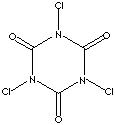Originally posted by solo
Immobilization of HX: [Hmim]X as Halogenating Agent, Recyclable Catalyst and Medium for Conversion of Alcohols to Alkyl Halides
WU, Hai-Hong( ) SUN, Jing( ) YANG, Fan( ) TANG, Jie*( ) HE, Ming-Yuan( )
Chinese Journal of Chemistry, 2004, 22, 619 621
Direct Link URL: http://home.ripway.com/2005-1/247174/ConversionofAlcoholstoA...
Alternate URL: http://host.picturewizard.com/2005-1/247174/ConversionofAlco...
Abstract
HX is immobilized by reaction of halogen acid with methylimidazole, and the formed ionic liquid [Hmim] was used as halogenating agent, catalyst as
well as medium for conversion of alcohols to alkyl halides. Excellent yields were obtained. The halides produced could be easily separated from the
reaction mixture via simple decantation, and the ionic liquid [Hmim]X could be regenerated conveniently by adding equivalent of halogen acids followed
by removal of water.
Keywords halogenation, ionic liquid, alcohol, alkyl halide |


